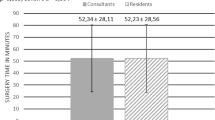Abstract
New generation flexible ureterorenoscopes offer an improved deflection mechanism and a stiffer sheath compared to their predecessors. We aimed to determine if these improvements in design lead to a higher efficacy in the treatment of nephrolithiasis. Ninety patients with upper urinary tract calculi were included into a retrospective analysis. Twenty-nine cases were treated with the conventional flexible ureterorenoscope (11274 AA, Karl Storz Endoscopy, Germany) and 61 cases were treated with the new generation device (Flex-X, Karl Storz Endoscopy). Patients’ and stone characteristics, intraoperative data, treatment success and complications were retrieved from the charts and compared between the two groups. Preoperative data were comparable in both groups. Whereas stone access was also comparable (97 vs. 100%; n.s.), immediate treatment success was significantly higher for the new flexible scope (70 vs. 38%; p = 0.003). For the subgroup of lower pole stones, stone access was possible in 94 versus 100% (n.s.) and treatment success was 31 versus 69% (p = 0.0004) for the conventional and the new generation device, respectively. No major complications were observed, minor complications were comparable in both groups. Our study suggests an advantage of the new generation flexible ureterorenoscopes compared to their predecessors. They offer an increased stone free rate especially in the treatment of lower pole stones. It seems therefore advisable to switch to the latest generation flexible devices.
Similar content being viewed by others
References
Marshall VF (1964) Fiber optics in urology. J Urol 91:110–114
Takayasu H, Aso Y, Takagi T et al (1971) Clinical applications of fiber-optic pyeloureteroscopy. Urol Int 26:97–104
Afane JS, Olweny EO, Bercowsky E et al (2000) Flexible ureteroscopes: a single center evaluation of the durability and function of the new endoscopes smaller than 9Fr. J Urol 164:1164–1168
Johnson GB, Portela D, Grasso M (2006) Advanced ureteroscopy: wireless and sheathless. J Endourol 20:552–555
Wendt-Nordahl G, Trojan L, Alken P et al (2007) Ureteroscopy for stone treatment using new 270 degrees semiflexible endoscope: in vitro, ex vivo, and clinical application. J Endourol 21:1439–1444
Traxer O, Dubosq F, Jamali K et al (2006) New-generation flexible ureterorenoscopes are more durable than previous ones. Urology 68:276–279
Johnson GB, Grasso M (2004) Exaggerated primary endoscope deflection: initial clinical experience with prototype flexible ureteroscopes. BJU Int 93:109–114
Pasqui F, Dubosq F, Tchala K et al (2004) Impact on active scope deflection and irrigation flow of all endoscopic working tools during flexible ureteroscopy. Eur Urol 45:58–64
Chiu KY, Cai Y, Marcovich R et al (2004) Are new-generation flexible ureteroscopes better than their predecessors? BJU Int 93:115–119
Cannon GM, Smaldone MC, Wu HY et al (2007) Ureteroscopic management of lower-pole stones in a pediatric population. J Endourol 21:1179–1182
Grasso M, Ficazzola M (1999) Retrograde ureteropyeloscopy for lower pole caliceal calculi. J Urol 162:1904–1908
Portis AJ, Rygwall R, Holtz C et al (2006) Ureteroscopic laser lithotripsy for upper urinary tract calculi with active fragment extraction and computerized tomography followup. J Urol 175:2129–2133
Breda A, Ogunyemi O, Leppert JT et al (2008) Flexible ureteroscopy and laser lithotripsy for single intrarenal stones 2 cm or greater-is this the new frontier? J Urol 179:981–984
Michel MS, Knoll T, Ptaschnyk T et al (2002) Flexible ureterorenoscopy for the treatment of lower pole calyx stones: influence of different lithotripsy probes and stone extraction tools on scope deflection and irrigation flow. Eur Urol 41:312–316
Ankem MK, Lowry PS, Slovick RW et al (2004) Clinical utility of dual active deflection flexible ureteroscope during upper tract ureteropyeloscopy. Urology 64:430–434
Acknowledgments
The authors thank Dr. Kadir Önem for his support on statistical analysis.
Conflict of interest
No competing financial interest exists.
Author information
Authors and Affiliations
Corresponding author
Additional information
Gunnar Wendt-Nordahl and Tuna Mut contributed equally to this work.
Rights and permissions
About this article
Cite this article
Wendt-Nordahl, G., Mut, T., Krombach, P. et al. Do new generation flexible ureterorenoscopes offer a higher treatment success than their predecessors?. Urol Res 39, 185–188 (2011). https://doi.org/10.1007/s00240-010-0331-0
Received:
Accepted:
Published:
Issue Date:
DOI: https://doi.org/10.1007/s00240-010-0331-0




